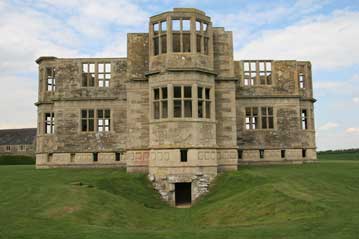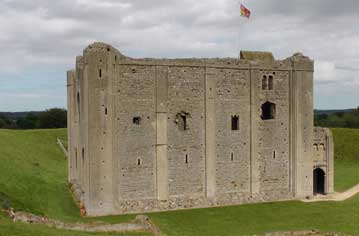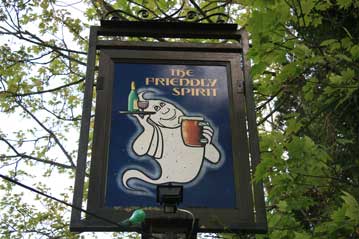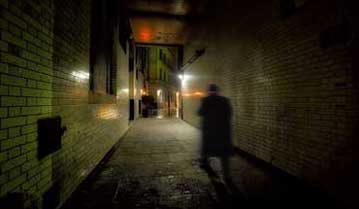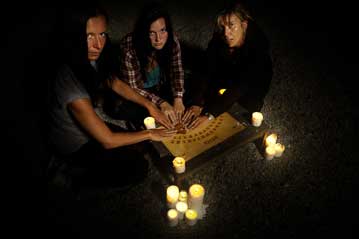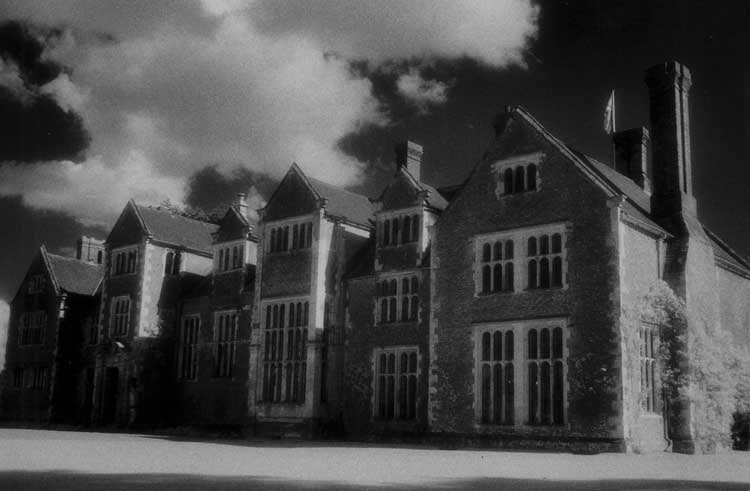
A Selection Of Surrey Hauntings
The A3, Burpham Nr. Guildford, Surrey
On Wednesday December 11th 2002, Surrey Police received several calls from motorists to say that a car had veered off the A3 with its headlights blazing.
But when officers arrived at the scene they could find no sign of a crashed vehicle, it appeared to have vanished without trace.
A further search, however, was ordered - and the results were chilling.
For, just twenty yards from the supposed "crash scene," police found the wreckage of a car containing the remains of a man, buried in twisted undergrowth. Its lights were off - the battery had long since died - and the body was little more than a skeleton.
Surrey Police later revealed that the crash had, in fact, happened in July 2002, and that the vehicle had lain undiscovered for close on five months.
The motorists who had originally alerted the police were, therefore, left to ponder the eerie possibility that what they had seen was a ghostly re-enactment of the original accident.
Guildford Castle
Although a castle was probably built in Guildford shortly after the Norman Conquest of 1066, all that remains of the earlier fortress is the motte on which the current castle keep was built, probably in the early 12th century. Initially it would have been an important stronghold intended to protect the strategically important route between London and the south coast as the Norman’s tightened their grip on their newly conquered dominion.
In the late 12th Century the Keep became the headquarters of the Sheriff and was pressed into service as the county gaol for Surrey and Sussex. Many of those incarcerated here were accused of serious crimes such as murder and were being within the mighty castle walls pending the arrival of the courts to hear their case. Those found guilty would be returned to the keep to await their execution.
The castle remained a place of imprisonment until the early 1600’s when the prisoners went elsewhere and thereafter it fell into disrepair. In the late 19th century the castle's then owner, Lord Grantley of Wonersh, sold it to Guildford Corporation who opened the grounds as a pleasure park in 1888. During a massive restoration project between 2003 and 2004 floors and a roof were put back for the first time in over 400 years, at which time the original battlements and other features were re-discovered.
The renovation appears to have also disturbed the slumbers of some of the castle’s long ago residents. Families entering the ground floor area where the prisoners were kept have come running out, carrying their children who are almost hysterical. The children, it transpires, have been frightened by an emaciated figure that they have seen chained to the walls. Philip Hutchinson, the castle’s Custodian – who also operates the popular Guildford Ghost Walk – explains that the children, who knew nothing of the history of the keep, have seen the figure in the area where the prisoners were most certainly kept. “On many occasions,” he continues, “fetters were ordered so that prisoners could be chained to the walls.”
Philip himself has experienced inexplicable phenomenon at the castle. In February 2008, as he was working inside the keep preparing it for the upcoming summer season, he left to go on his lunch break. Leaving all the lights and the heaters on to warm the interior after the long winter closure, he closed the door behind him and locked the heavy padlock. When he returned from lunch, the padlock was still locked, but when he got inside, all the lights and heaters had been switched off manually. No-one, as far as he could ascertain, had entered the room whilst he was away.
Guildford Castle Keep is a special place with the mark of history most certainly daubed across its time scarred walls. The fact that the spirits of some of those who have been associated with its rich and diverse past apparently still linger here, makes a visit a must by all those who wish to seek and experience a location that is both haunted and haunting.
Ham House, Petersham
Known as the "sleeping beauty" of country houses this splendid building has changed little since the 17th century.
Built in 1610, as a modest country residence by Sir Thomas Vavasour, the house was acquired in 1637 by William Murray, 1st Earl of Dysart who, as a youth, had enjoyed the enviable position of whipping boy to the future Charles 1st. Chief amongst his duties was that he should be punished for the Prince's misbehaviour!
In 1651 he bequeathed the house to his daughter Elizabeth Murray, Countess of Dysart, wife of Sir Lyonel Tollemache by whom she had eleven children.
Rumours were rife that she was also the mistress of Oliver Cromwell who, gossip maintained, was the father of her second son, Thomas. With the Restoration of the monarchy, she became the lover of the Duke of Lauderdale, subsequently marrying him in 1672, following the death of Sir Lyonel.
An intriguing tale tells of the six year old daughter of a 19th century Butler at Ham House who was invited by the then owners, the Ladies Tollemache, to come and stay at the property. In the early hours of the morning, the girl awoke to find a little old lady scratching with her fingers upon the wall by the fireplace. Sitting up to get a better view of the stranger, she seemed to disturb the woman who came to the foot of the bed and proceeded to stare at the child with a fixed and horrible gaze. This sent the child into screaming hysterics, which in turn alerted other members of the household who came racing to the room. They could find no sign of the old woman but, on searching the wall, they uncovered a secret compartment in which were papers that proved Elizabeth, the Countess of Dysart, had murdered her first husband in order that she might marry the Duke of Lauderdale.
Hampton Court Palace
In 1541 Cardinal Wolsey constructed a magnificent palace on the banks of the Thames. He lived in the completed building in regal splendour and entertained on such a lavish scale that his hospitality became the talk of Europe. But, when he failed in his attempts to persuade the Pope to annul the marriage of Henry VIII and Catherine of Aragon, his fate and downfall were sealed. In a last desperate attempt to buy his way back into Royal favour, the crestfallen cardinal presented his "jewel on the Thames" to Henry, who gratefully accepted the gift and then promptly summoned Wolsey to answer charges of treason. Frail in both mind and body, the dejected cleric headed south from his see at York, but died en route at Leicester, wishing that he had "served God as diligently as I have served my King".
Henry wasted no time in introducing his second wife, Anne Boleyn, to the splendours of Wolsely’s Palace and, following her beheading in 1536, her ghost remained behind to drift forlornly through its passages and chambers wearing a blue dress.
Typically, Henry was courting Jane Seymour while Anne was still alive. When she became his third wife, however, she does appear to have brought the despotic tyrant genuine contentment and did provide him with his longed for son and heir, Edward, born on 12th October 1537. Sadly, shortly afterwards, Jane Seymour died (from natural causes) and ever since her phantom has made an annual pilgrimage to the Palace, on the anniversary of her sons birth. Holding an unflickering candle, her head bent in sorrow, she glides eerily along corridors, passes through closed doors and has, on occasion, shocked witnesses into resigning from the palaces staff.
But it is Henry's fifth wife Catharine Howard, who makes the most dramatic return to Hampton Court Palace.
She was still a teenager when she married the King in 1540, although she was certainly sexually experienced. Her past liaisons had included her music master, Henry Mannock, and a youthful nobleman named Denham. She found Henry physically repulsive and had soon sought solace in the arms of a young man at court, Thomas Culpepper. Servants tittle-tattle, brought her previous indiscretions to light and, not long afterwards, her adultery was exposed.
Henry was furious at the betrayal. The unfortunate Culpepper was soon languishing in the Tower of London and was subsequently executed (as was Mannock), and his unfaithful Queen found herself imprisoned in her chambers at Hampton Court.
Brooding on her inevitable fate, the young girl, decided that her only hope lay in meeting with her husband, and pleading with him to spare her life.
On 4th November 1541, knowing that Henry would be at prayer in the chapel, she broke free from her guards and ran through what is now known as the "Haunted Gallery" where she threw herself at the chapel's locked door, screaming at her husband to grant her an audience. The King listened in stony silence and, moments later, the guards had recaptured the hysterical girl and were dragging her back to her chambers.
On 13th February 1542, at just twenty years of age, Catharine Howard went bravely to the block: "I die a Queen but I had rather died the simple wife of Tom Culpepper. May God have mercy on my soul. Pray for me". She was smiling when the axe fell.
Ever since, servants noblemen and even modern day wardens have reported seeing her ghost, dressed in a white gown, racing towards the chapel, her face contorted into a terrifying, unearthly scream.
Many visitors have reported a peculiar, icy coldness and intense feeling of desperate sadness around the doors of the chapel itself, and some people have even witnessed a disembodied, ringed hand knocking upon the door.
As recently as 1999 two women on separate guided tours fainted at exactly the same spot in the "Haunted Gallery". On regaining consciousness, both victims reported a sudden chill and said they felt as if they had been punched shortly before passing out.
Hampton Court has more than thirty ghosts residing within its ancient fabric. History certainly does come alive here and to explore its fascinating rooms and passages is to walk with kings and queens, lords and ladies, the famous and forgotten.
The Silent Pool. Nr. Dorking, Surrey.
A strange and uncanny stillness hangs over this sinister little lake that ripples in a lonely setting at Shere under the North Downs.
In the 13th century, this whole area was dense forest and legend holds that, one day, a stranger dressed in rich apparel arrived at the home of a poor woodcutter who lived nearby. The man was a widower and his home was little more than a hovel that he shared with his young son and beautiful teenage daughter. But, he invited the stranger to partake of whatever hospitality he could offer him.
As the noble visitor refreshed himself, the woodcutter's daughter went out to bathe in the Pool. It was a warm day and she was enjoying an invigorating swim, when she heard someone crashing through the undergrowth. She headed fro the bank but, before she could reach dry land, the noble stranger sped from the forest and reared his horse over her clothing. The girl dived back in the water and the stranger spurred his horse into the lake after her. The girl was a poor swimmer and was soon floundering in the deepest part of the pool where her distress greatly amused the stranger, who continued towards her. At that moment her brother, having heard his sisters cries, raced to the pool and flung himself in to assist. But he too was a poor swimmer and, moments later; they had both slipped beneath the surface and drowned. Unmoved by their plight, the man rode from the water and galloped away.
A little while later, the woodcutter came to the pool searching for his children. Spotting their lifeless bodies floating on the surface, the grief-stricken man pulled them from the water and laid them upon the banks.
It was then he noticed a feather from the stranger's hat caught upon a tree and realised what had happened.
Vowing vengeance, he wandered the district intent on discovering the murderers identity. He soon found out that the noble stranger had been none other than Prince John, Regent of Britain whilst his brother, Richard, was away fighting the Crusades.
Through the machinations of one of John's many enemies, the woodcutter secured an audience with the Regent at Guildford Castle. John failed to recognise the poor woodcutter and, having apparently forgotten his wickedness, expressed outrage at the murder of the children, declaring that the man responsible was to be punished. At which point the woodcutter threw down the feather and denounced John for the villain he was.
Sadly, the legend does not reveal how the audience finished.
But tradition states that it was the fate of the woodcutter's children that determined the barons in their resolve to confront John, and force him into the sealing of Magna Carta on Runnymede in 1215.
Furthermore, it is the long ago tragedy that is believed to account for the peculiar and uncanny silence that often seems to emanate from the ominous pool, where the wraith of the murdered girl is, on occasion, said to drift beneath its rippling, sullen waters.


